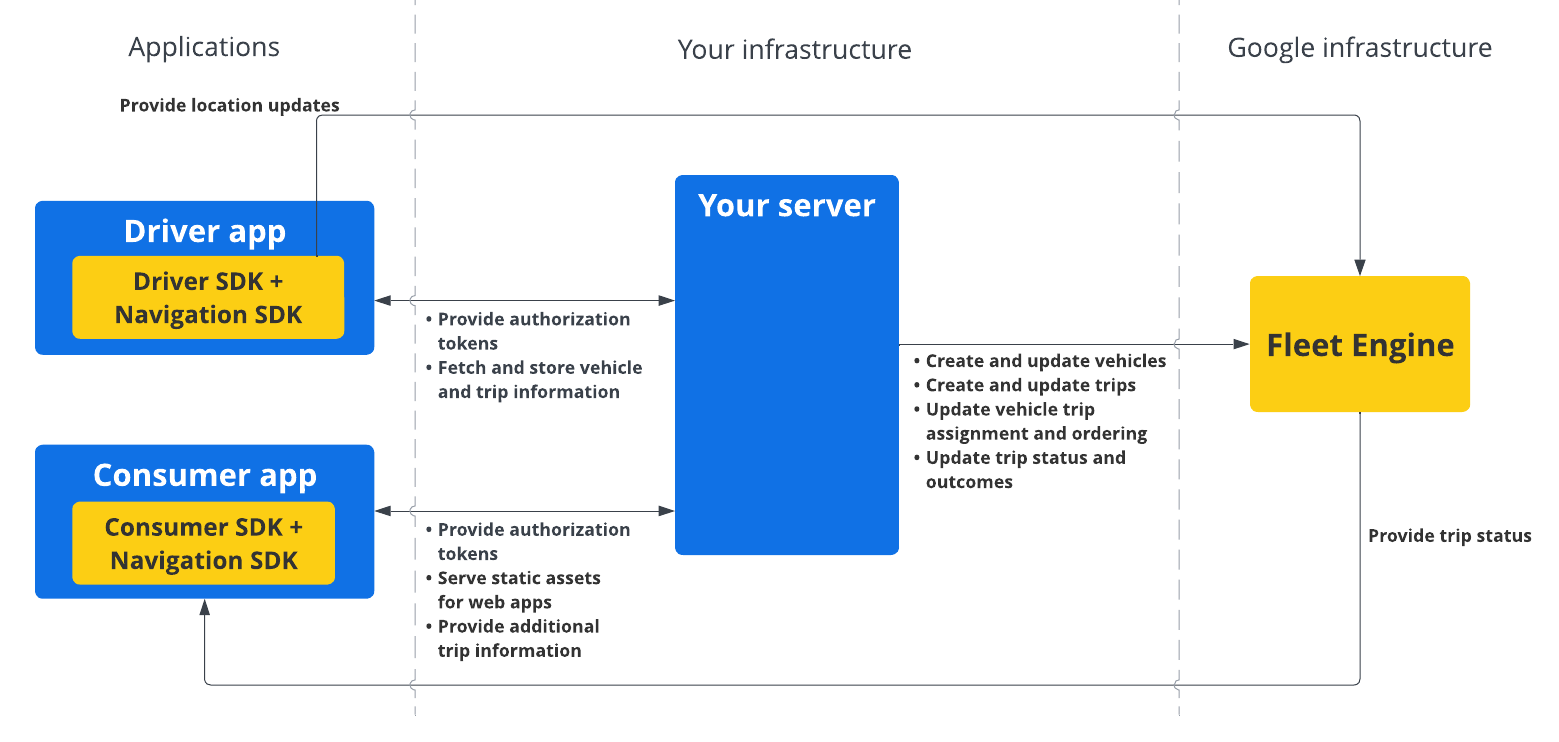O SDK Driver é um kit de ferramentas de apps para dispositivos móveis e um componente fundamental do Fleet Engine. Com esse SDK, o app para motoristas pode gerenciar viagens atribuídas e ativar recursos de navegação e rotas para motoristas.
Antes de começar
Este guia pressupõe que você já leu o seguinte:
- Fundamentos do Fleet Engine.
- O modelo de dados para veículos.
- O modelo de dados para viagens sob demanda.
- Como configurar o Fleet Engine.
- Como criar e usar veículos no Fleet Engine.
O que é o SDK Driver para viagens sob demanda?
O SDK do driver comunica a localização do veículo e as atualizações de viagem ao Fleet Engine para que ele possa rastrear os veículos e as viagens atribuídas. Basicamente, o SDK usa um listener de eventos para enviar atualizações de localização e coordenadas de latitude/longitude, além do segmento de rota atual e do destino do SDK Navigation para o Fleet Engine quando o motorista começa a dirigir.
Por que usar o SDK Driver para viagens sob demanda?
O SDK do driver facilita a integração com o Fleet Engine para atualizações nas rotas do motorista. Com esse SDK, o motorista pode usar um único app para gerenciar tarefas e navegar como faria com a versão para consumidor do Google Maps, mas sem precisar mudar para outro app.
O que você pode fazer com o SDK Driver para viagens sob demanda
Use o SDK Driver para viagens sob demanda e comunique o seguinte ao Motor de frota:
- A posição em tempo real de um veículo em um mapa.
- Coordenadas de latitude/longitude para os pontos de referência da viagem fornecidos pelo SDK Navigation.
- Distância restante até o próximo ponto de parada.
- Hora estimada de chegada ao próximo ponto de parada.
- O trajeto que o veículo precisa fazer, conforme fornecido pelo SDK Navigation.
Como o SDK do Driver para viagens on demand funciona
O SDK Driver depende do SDK Navigation para informações de roteamento e destino. Junto com as informações do SDK Navigation, o SDK Driver se integra ao app do motorista e fornece ao Fleet Engine um fluxo de atualizações de local, coordenadas de latitude/longitude, distância restante e ETAs. Todas as outras atualizações de dados do veículo precisam ser enviadas ao back-end do cliente, que transmite os dados ao Fleet Engine.

Como usar o SDK Driver para viagens sob demanda
Selecione sua plataforma para saber como começar a usar o SDK Driver.
Android
| 1 | Receber o SDK Driver para Android | Para mais informações, consulte Receber o SDK Driver. |
| 2 | Configurar um projeto do console do Google Cloud | Para mais informações, consulte Configurar um projeto do console do Google Cloud. |
| 3 | Declarar dependências | Para mais informações, consulte Declarar dependências. |
| 4 | Criar tokens de autenticação | Para mais informações, consulte Criar tokens de autenticação. |
| 5 | Inicializar o SDK Driver | Para mais informações, consulte Inicializar o SDK Driver. |
| 6 | Prepare o veículo | Para mais informações, consulte Preparar o veículo. |
| 7 | Definir os detalhes da viagem | Para mais informações, consulte Definir os detalhes da viagem. |
iOS
| 1 | Receber o SDK para motoristas para iOS | Para mais informações, consulte Receber o SDK Driver. |
| 2 | Configurar um projeto do console do Google Cloud | Para mais informações, consulte Configurar um projeto do console do Google Cloud. |
| 3 | Criar tokens de autenticação | Para mais informações, consulte Criar tokens de autenticação. |
| 4 | Inicializar o SDK Driver | Para mais informações, consulte Inicializar o SDK Driver. |
| 5 | Prepare o veículo | Para mais informações, consulte Preparar o veículo. |
| 6 | Definir os detalhes da viagem | Para mais informações, consulte Definir os detalhes da viagem. |
A seguir
Consulte a documentação da plataforma em que você quer configurar o SDK Driver:

